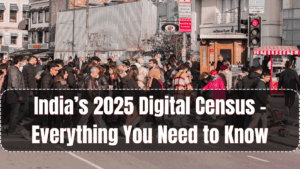In a historic first, the Government of India has officially launched the Digital Census 2025, transforming the traditional enumeration process into a fully tech-driven initiative. Spearheaded by the Office of the Registrar General and Census Commissioner, this marks the world’s largest digital population survey, with all data collection, verification, and processing now being conducted through mobile apps and secure cloud-based platforms.
This monumental step is part of India’s broader Digital India campaign and will redefine how population data is captured, analyzed, and utilized for policy-making. As of September 2025, the digital census process is live across all states and union territories.

Key Features of the Digital Census 2025
Unlike previous censuses conducted on paper, the 2025 digital census uses mobile tablets and geotagged mapping to ensure accuracy, speed, and real-time verification. Enumerators have already begun house-to-house visits using secure Android-based apps developed by NIC (National Informatics Centre).
Salient features of the digital census:
-
Online self-enumeration portal for tech-savvy households
-
Use of Aadhaar and mobile number verification for identity confirmation
-
Real-time data validation through AI-integrated survey software
-
Multilingual interface for all 22 scheduled Indian languages
-
Encrypted cloud storage and central dashboard monitoring for data security
All households will now have a digital census code, enabling faster updates and seamless integration with welfare databases and service delivery platforms.
Participation Process for Citizens
Citizens can participate in the digital census in two ways:
-
Enumerator Visit: Government-appointed enumerators will visit households and record details directly into a tablet-based app. Each entry is time-stamped and geo-verified.
-
Self-Enumeration Option: Individuals can log in to the official census portal (censusindia.gov.in), enter their household data, and generate a QR-linked reference code for validation during the field visit.
Documents such as Aadhaar, Voter ID, and utility bills may be requested for cross-verification, though they are not mandatory unless data inconsistencies are detected.
What the Census Will Cover in 2025
The India 2025 digital census will collect data on:
-
Demographics: Age, sex, religion, marital status, caste, and family size
-
Education: Literacy, school attendance, highest qualification
-
Employment: Nature of occupation, industry type, skill category
-
Housing: Type of house, number of rooms, water, electricity, toilet access
-
Migration: Last place of residence, reason for migration
-
Digital Inclusion: Smartphone usage, internet access, digital literacy
The inclusion of digital access parameters is a new addition in 2025, enabling policymakers to bridge digital divides and expand connectivity.
Benefits of Going Digital with the Census
The shift to a digital census has multiple advantages, both for the government and citizens:
-
Faster data processing: Initial results are expected within 3 months, compared to over a year previously
-
Cost reduction: Savings on paper, printing, and logistics have reduced census expenses by 40%
-
Real-time monitoring: Field progress can be tracked daily, reducing duplication and fraud
-
More accurate results: AI-based checks prevent errors, while geotagging ensures location accuracy
-
Easier updates: Future revisions (birth, death, migration) can be logged using the same census household ID
This modernized census will feed directly into India’s development indicators, urban planning, education distribution, healthcare delivery, and electoral roll alignment.
FAQs
What is the digital census of India?
It is India’s first-ever paperless population count where data is collected using mobile apps and online platforms instead of paper forms.
Is participation in the digital census mandatory?
Yes, participation in the national census is mandatory under the Census Act, 1948, whether digitally or through enumerator visits.
Can I complete the census process online?
Yes, you can use the official portal for self-enumeration and provide details in advance. However, field verification may still take place.
Is my personal data secure in the digital census?
Yes, all data is encrypted and stored on secure government servers, with multiple layers of identity protection and access control.
What is the last date to complete the digital census?
The field enumeration will continue until December 15, 2025, while self-enumeration is open until October 30, 2025.
Click here to know more.
